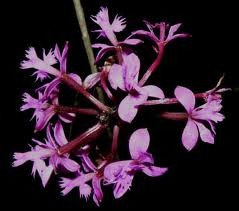The reed-stem epidendrum, also called the reed orchid, is perhaps the most easy-to-care-for orchid available. Unpretentious and low-maintenance, the reed-stem epidendrum provides striking blooms without much work. This orchid can grow indoors or outdoors and can be placed in the ground or grown in pots. As long as you provide the plant with the appropriate conditions, it will thrive most anywhere. If you are looking to begin growing orchids, this variety is an easy one to start with.
Difficulty: Moderate
Instructions
Things You’ll Need:
- Pots with drainage holes
- Compost
- Fertilizer
-
Place your reed orchid in a sunny location. Reed orchids require an abundance of light to produce their signature blooms.
-
Plant your orchid in an area that has mild temperatures. Reed orchids need daytime temperatures of between 60 and 90 degrees Fahrenheit and nighttime temperatures between 50 and 65 degrees. Bring your outside orchid inside when the temperatures begin to drop below 50 degrees, but remove any bugs on the plant first.
-
Plant your orchid in a raised bed outside or place it inside pots that have drainage holes in the bottom. Keep the pots either indoors or outdoors. Reed orchids also typically grow well on cork and rocks.
-
Provide your orchids with fertilizer. Reed orchids tend to grow best when fed with compost that is composed of tree bark, sphagnum moss and tree fern fiber. If you choose to use compost that is made only of tree bark, feed your orchid fertilizer that is high in nitrogen at every other watering.
-
Keep the roots moist by watering the reed orchid whenever the soil begins to look dry. If your orchid is potted, water it until you begin to see water seep through the drain holes. If the orchid is planted in the ground, provide enough water for the medium to look soggy.
-
Inspect your reed orchid regularly for signs of insects or disease. Slugs and snails often feast on the reed orchid and ants tend to make this plant their home. Use snail or slug traps to remove them or sprinkle ant repellent around the flower. Red and shriveled leaves are often signs of a root fungus which can be resolved with the help of antifungal plant products.
Tips & Warnings
-
If your reed orchid isn’t blooming frequently, it is probably not receiving enough sun.
-
Repot your orchid in fresh soil often to prevent fungus from occurring.


Deprecated: strpos(): Passing null to parameter #1 ($haystack) of type string is deprecated in /home/agriviek8Qv/agriviet.net/public_html/wp-includes/comment-template.php on line 2522